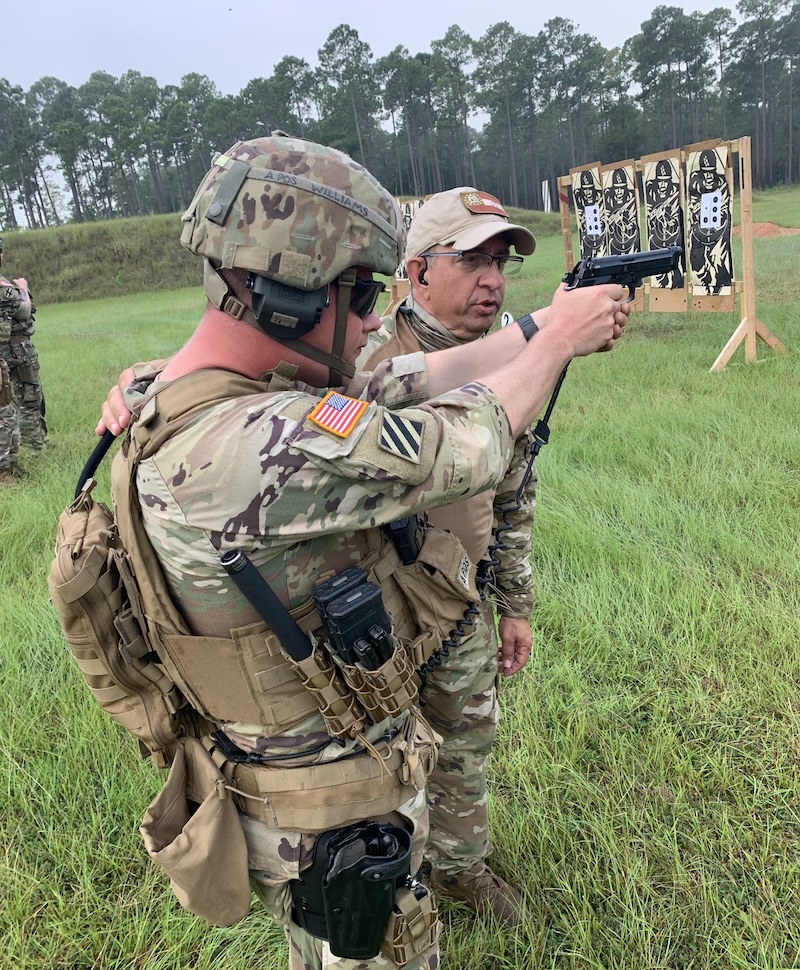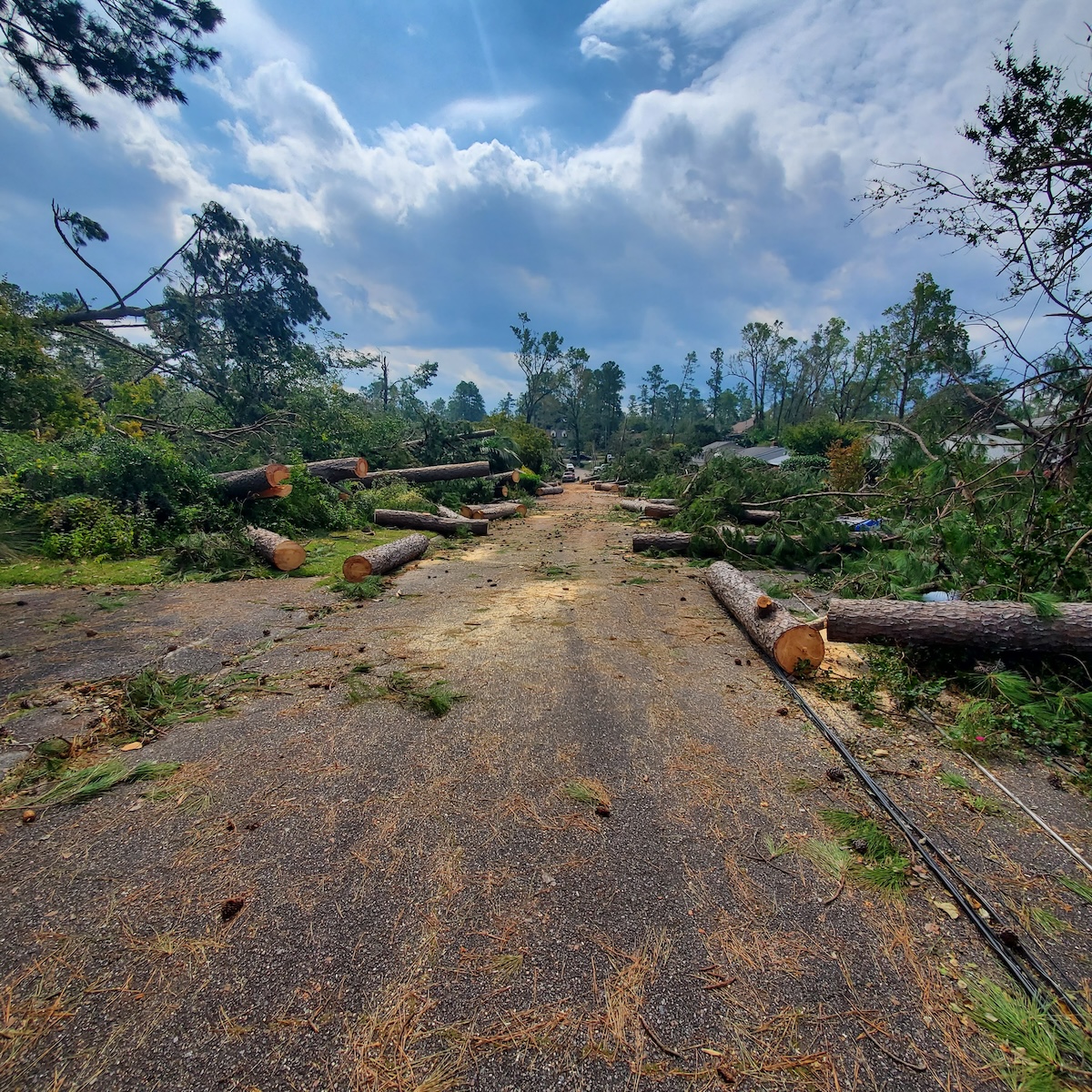1st Brigade Georgia State Defense Force participates in Defender Northwest
1st Brigade Georgia State Defense Force participates in Defender Northwest
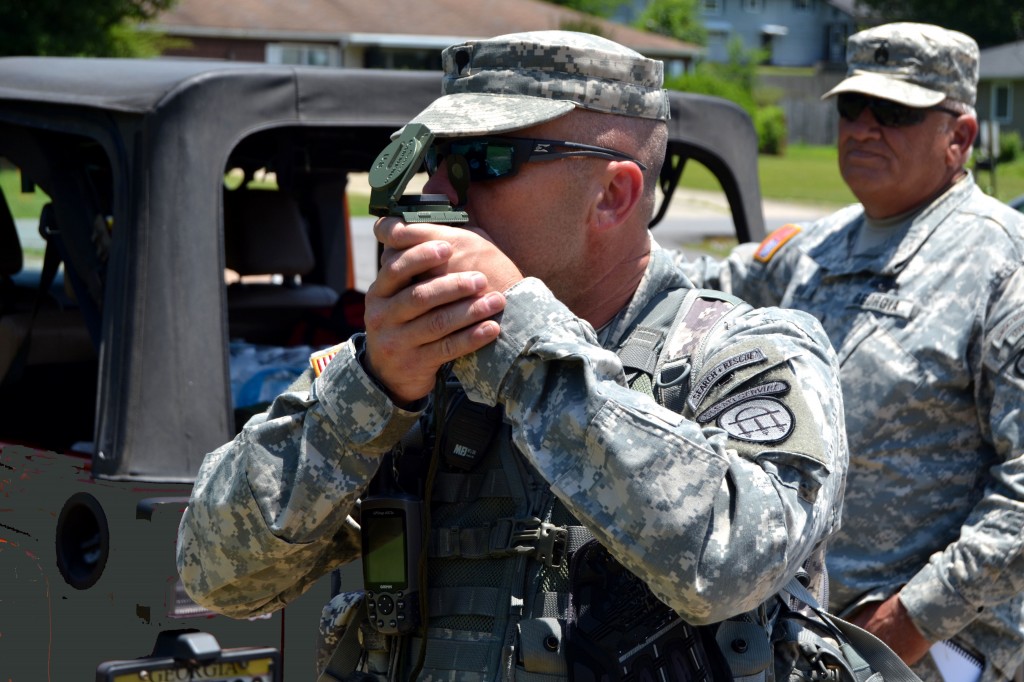
Spc. Michael Elliott, a Soldier of the combined Search and Rescue Teams of the 1st and 4th Battalion, 1st Brigade, Georgia State Defense Force (GSDF) takes an azimuth reading through his lensatic compass during Defender Northwest Georgia Field Training Exercise (FTX) 2015. He is guiding his fellow team members on a search for evidence that a tornado survivor passed through the area, insuring that no ground is overlooked. The FTX tests the capabilities of the Soldiers and staff of the GSDF in their ability to respond to a disaster. (Georgia State Defense Force photo by Master Sgt. Mark D. Woelzlein, Public Affairs Office)
Clark Creek South Campground, Acworth, Georgia, June 5-7, 2015 By MSG Mark Woelzlein – The call for help goes out and the Soldiers of the 1st Brigade, Georgia State Defense Force (GSDF) respond with enthusiasm. They arrive at the designated locations, the 1st Brigade Tactical Operations Center (TOC) along with 2nd and 3rd Battalion in a camping area at Lake Allatoona, just a few miles north of the city of Acworth, Georgia and the Soldiers of the 1st and 4th Battalion at the Georgia National Guard Center in Rome, Georgia. They are here for Defender Northwest Georgia 2015, the 1st Brigade field training exercise (FTX), a scenario driven exercise where a notional tornado has damaged the area near Acworth and Rome, Georgia and the Governor of the State of Georgia has called the GSDF to assist where needed.
The Soldiers arrive throughout Friday evening on June 5, 2015, after a warm and humid day to set up camp and make final preparations for the next day’s activities. Many have already worked a full day and some drove a considerable distance to get here, but no complaints are heard as all are dedicated to the mission of saving the lives of their friends and neighbors. Under the direction of Col. W. Brad Bryant, the commander of the 1st Brigade GSDF, Maj. Herb Jones, the brigade Operations Officer and the acting Incident Commander, issues instructions to the four battalions. Chief Warrant Officer 3 Kevin Ward, the brigade Assistant Operations Officer, sifts through all the reports received from the battalions to give the Incident Commander a complete picture of the affected area. The entire Brigade Staff stays busy to ensure all of the Soldiers of the 1st Brigade are able to complete their missions. The Soldiers of 1st and 4th Battalion assembling in Rome, Georgia submit progress reports through a web based reporting system as well as the Soldiers of the 2nd and 3rd Battalions located at the camp near Acworth, Georgia. By the end of the evening, all were ready to start operations.
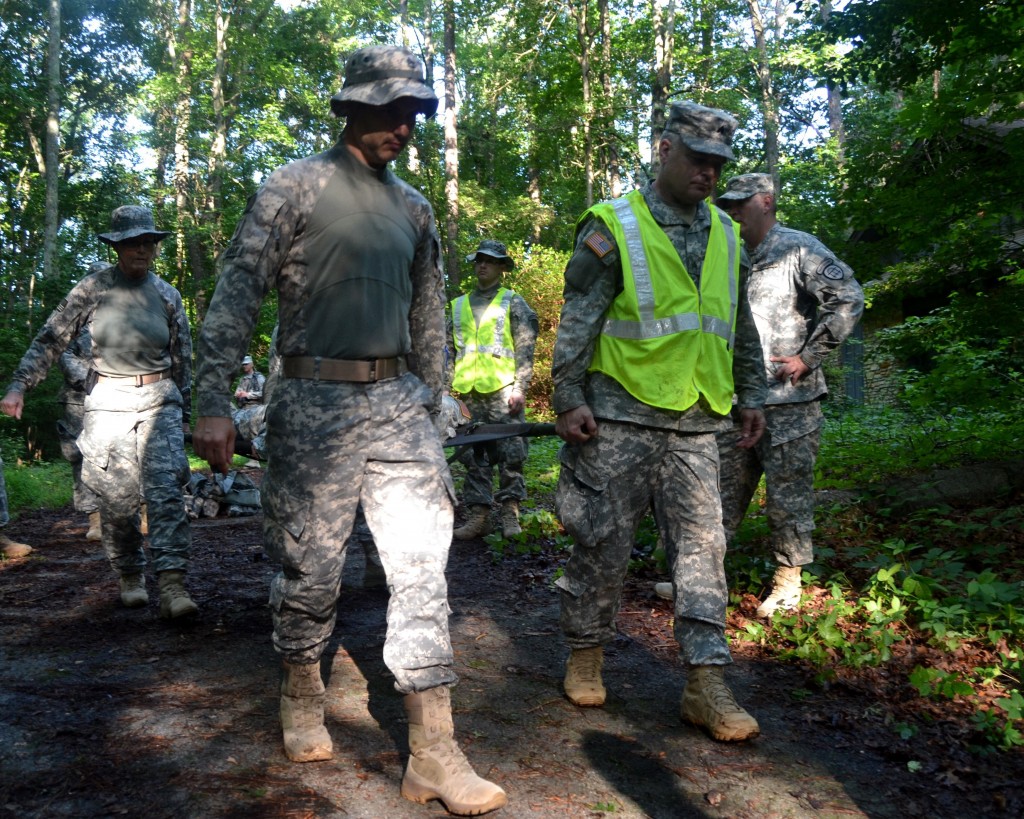
CLARK CREEK SOUTH CAMPGROUND, Acworth, June 6, 2015 – Soldiers of 2nd and 3rd Battalion, 1st Brigade, Georgia State Defense Force (GSDF) safely move a simulated casualty to a location where emergency services can reach him and evacuate him during Defender Northwest Georgia Field Training Exercise (FTX) 2015. The FTX tests the capabilities of the Soldiers and staff of the GSDF in their ability to respond to a disaster. (Georgia State Defense Force photo by Master Sgt. Mark D. Woelzlein, Public Affairs Office)
On Saturday, June 6, 2015, the Soldiers of the four battalions awaken and receive orders from their officers. They practice techniques in Search and Rescue and conduct route reconnaissance through areas affected by the tornadoes. They are also here to practice survival skills they would need if the situation called for it. With Search and Rescue, the Soldiers practice techniques used to sweep over areas to find casualties and survivors. During a disaster, reports of survivors wandering about the area in a state of shock and in need of care are common. The Soldiers of 1st and 4th Battalion, led by Staff Sgt. Corey Ranic, move across Etowah Park in Rome, Georgia, in a formation that ensures that every inch of ground is inspected for evidence that the survivor passed through the area. When an order is received to sweep an area to look for survivors that are unable to move or are trapped, the Soldiers provide what first aid that they can and, if possible, safely move the victim to a casualty collection point where a group of casualties are cared for by a small team and where an ambulance can reach them. If the casualty cannot be moved, then the location is reported so rescuers with the proper equipment are brought in. All buildings in the search area are marked with an indicator to ensure that no structure is overlooked.
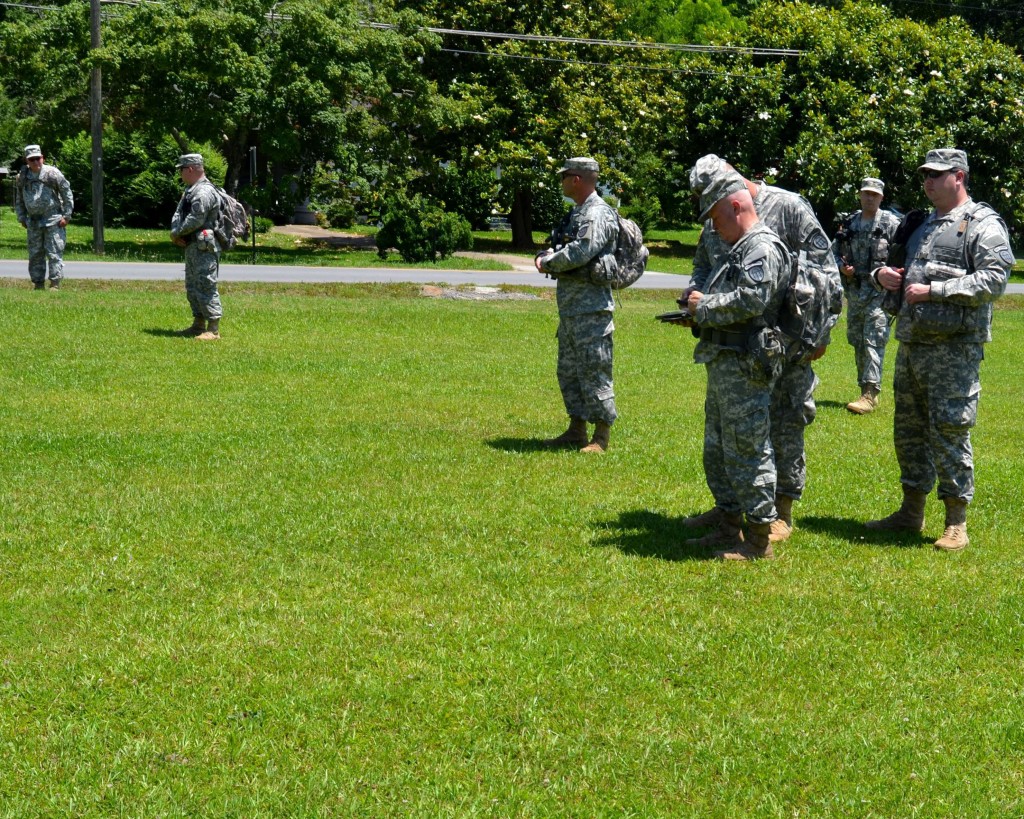
ETOWAH PARK, Rome, June 6, 2015 – Led by Staff Sgt. Corey Ranic, Soldiers of the combined Search and Rescue Teams of the 1st and 4th Battalion, 1st Brigade, Georgia State Defense Force (GSDF) pause and record items found during Defender Northwest Georgia Field Training Exercise (FTX) 2015. Staff Sgt. Ranic and his team is conducting a search for evidence that a tornado survivor passed through the area. The FTX tests the capabilities of the Soldiers and staff of the GSDF in their ability to respond to a disaster. (Georgia State Defense Force photo by Master Sgt. Mark D. Woelzlein, Public Affairs Office)
In a disaster, it is critical that routes throughout the affected areas be assessed for use by emergency services. With route reconnaissance, the GSDF is prepared to assist authorities in determining where roads are blocked or somehow damaged and cannot handle the movement of emergency services. Alternative routes are explored and reported to the Incident Commander. All reports of good routes, bad routes, empty buildings, downed power lines, casualties, survivors, etc. are reported to the Incident Commander through the use of standardized Spot Reports. Routine reports are submitted at pre-established times and spot reports have priority and are reported as they happen. Spot reports contain critical information that the Incident Commander uses to direct and prioritize emergency and rescue operations.
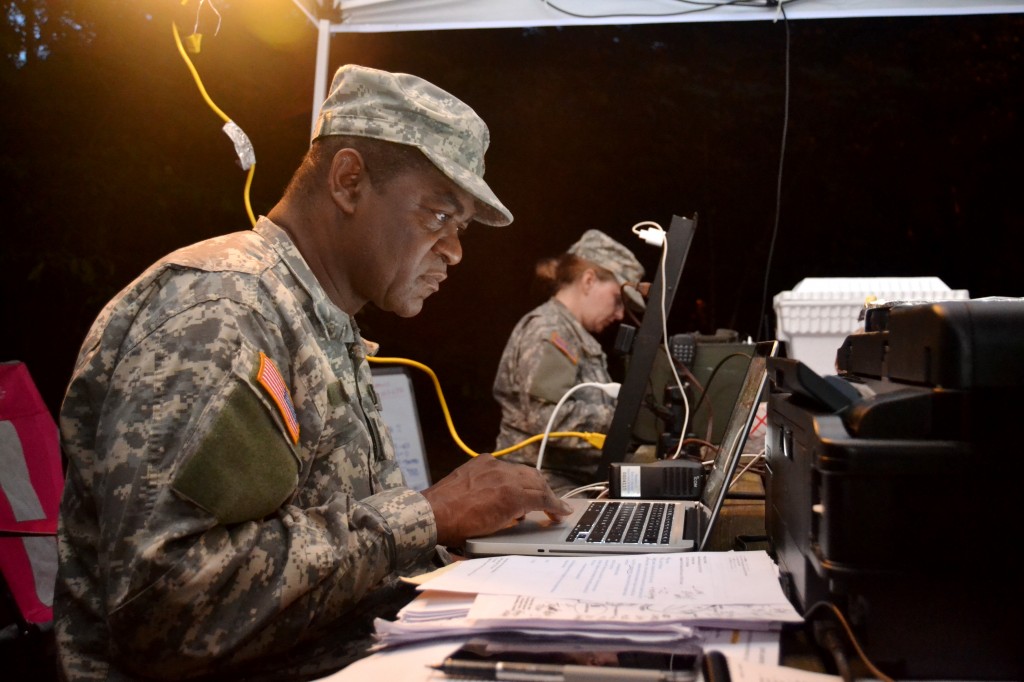
CLARK CREEK SOUTH CAMPGROUND, Acworth, June 5, 2015 – Maj. Herb Jones, the Operations Officer for 1st Brigade, Georgia State Defense Force (GSDF) and acting Incident Commander for Defender Northwest Georgia Field Training Exercise (FTX) 2015, scans over reports and prepares orders for the Soldiers. The FTX tests the capabilities of the Soldiers and staff of the GSDF in their ability to respond to a disaster. (Georgia State Defense Force photo by Master Sgt. Mark D. Woelzlein, Public Affairs Office)
As night falls, the Soldiers of the battalions complete the tasks that they are given. The final spot reports are submitted to the 1st Brigade TOC, and the battalion commanders gather information for their After Action Reports (AAR’s) and the weary Soldiers settle down, content that they completed all that was asked of them and more. The following morning as the sun rises, the Soldiers stir wherever they laid their heads. The breakfast meal is consumed and any task remaining to be completed or done to standard is finished. Final AAR’s are completed and final briefings are given to the Soldiers with congratulations on a job well done. The Soldiers of 1st Brigade return home with a well-deserved sense of accomplishment.
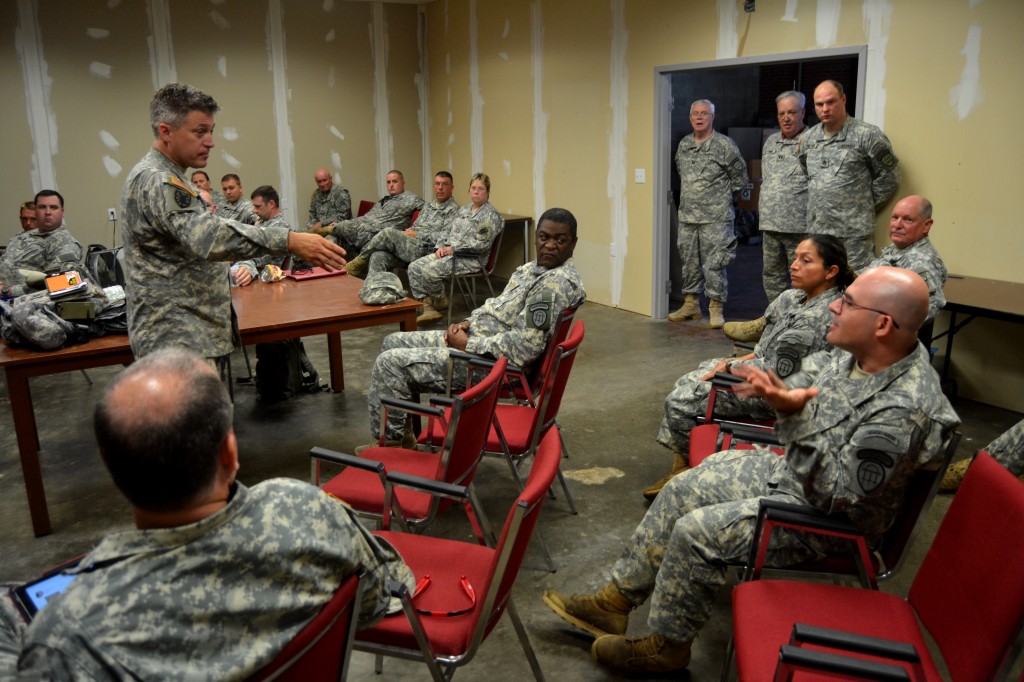
GEORGIA NATIONAL GUARD CENTER, Rome, June 6, 2015 – Capt. Hayden Collins, the Executive Officer of 1st Battalion, 1st Brigade, Georgia State Defense Force (GSDF) conducts a brief After Action Report with Soldiers of 1st and 4th Battalion about the morning missions during Defender Northwest Georgia Field Training Exercise (FTX) 2015. This report, along with others gathered throughout the FTX, will determine the training the Soldiers will do during future drills. The FTX tests the capabilities of the Soldiers and staff of the GSDF in their ability to respond to a disaster. (Georgia State Defense Force photo by Master Sgt. Mark D. Woelzlein, Public Affairs Office)

